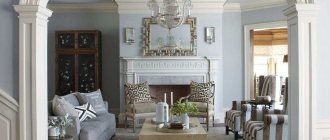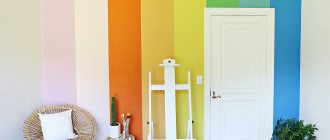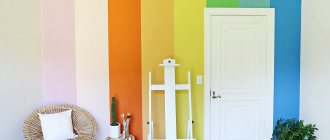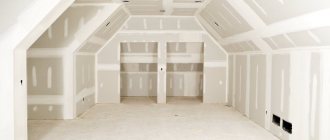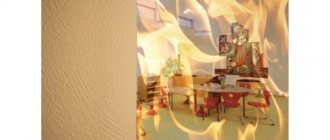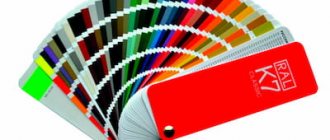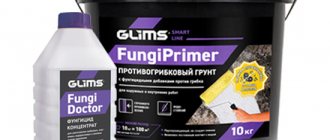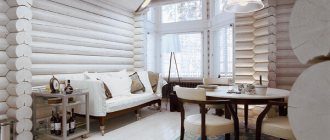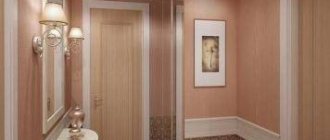What colors go together when painting walls?
There are three possible combinations:
- close or related colors: for example, two neutrals (black and white, gray and beige) or two cool pastels (blue and mint)
- “gradient”: tones of the same color of different saturation
- different colors: for example blue and red, green and orange
Oct 3
2013 Interesting materials:
Where is the best place to place your desk? Where is the best place to place the garden on the site? Where is the best place to plant basil? Where is the best place to plant onions? Where is the best place to plant rosemary? Where is the best place to study international relations? Where is the best place to install an air conditioner? Where is the best place to hang icons in the house? Where is the best place to store the funded portion of your pension? Where is the best place to stay in Istanbul?
Preparation
Renovation in the hallway is carried out in several steps:
- First, remove the old coating using a spatula; Advice! If wallpaper was pasted on the walls, before removing it, you should moisten it with water and let it stand for a couple of minutes. The paper will become wet and will be easier to remove from the surface.
- Next, remove all debris and dust from the ceiling, walls and floor;
- All cracks and grooves on the surface are puttied;
- Next, everything is primed and proceed to finishing plaster, which completely levels the surface;
- When the putty layer dries, it is sanded with fine sandpaper, wiped off dust and a deep penetration acrylic primer is applied. Now the hallway can be painted.
What color to choose
The choice of color for the walls in the hallway is influenced by its size and degree of illumination. In a small and narrow corridor, which is illuminated only by a chandelier, it is better to choose light colors. White, grey, soft blue or light beige shades work well. Also, for a small room it is worth coming up with a horizontal pattern that will visually expand the space.
We will need:
paint, putty, primer, paint roller, paint brush, special tape, stepladder, scraper, plastic film, sandpaper, putty knife, overalls and safety glasses.
We advise you to choose interior, water- and vapor-permeable, abrasion-resistant paints in light colors for the walls in the corridor. In recent years, water-based coatings have been in demand. Their main feature is environmental friendliness. They dry quickly and do not leave a specific smell after painting. We do not recommend using oil-based coatings in the corridor: despite the fact that they are more durable and hardy than water-based paints, such paints have a “toxic” chemical composition that is harmful to human health.
Before you start painting the walls , remove from the corridor all objects that impede access to the walls, cover the floor with plastic film, remove handles, sockets, and switches from the walls.
READ How to calculate how many blocks you need on a wall
How to paint the walls in the corridor without the help of others?
Corridor paint
Painting the corridor, as well as other rooms of the apartment, is the most affordable way to decorate it. With the help of modern paints you can create a beautiful interior of any color and texture, and realize any design ideas. When choosing a coloring composition for the corridor, it is important to take into account its performance properties. The paint for the apartment corridor must be moisture-resistant, wear-resistant, durable, resistant to mechanical stress, and durable. This room is most susceptible to pollution brought from the street and entrance, so the paint must be washable, withstanding numerous wet cleanings.
What kind of paint is suitable for the corridor? For these purposes, a group of water-dispersion compositions can be considered, since they have excellent vapor permeability and strength. Suitable types of water-dispersion paints:
Materials for decorating hallway walls and their colors
When it is already approximately clear what exact shapes and sizes the furniture in the hallway will be, you should determine the optimal color setting for yourself. A little variety, but at the same time lightness and simplicity, will be provided by paints and relief plaster. The corridor will be white, orange, greenish, coffee color or some other color. But without color variety, unless you add stripes, color shifts or shade transitions. Cladding panels sometimes have no pattern at all, but the natural material usually retains a multi-colored structure, be it wood or stone. Tile coverings are also placed on the walls - with patterns or in various color combinations. Art lovers should choose a design with murals or photo wallpaper. A “corner” of picturesque nature will not be out of place, as will the atmosphere in the spirit of the Middle Ages with its inherent shades.
Painting the walls
The shade on the wall becomes less saturated than in the container - you should remember this so that you don’t end up with a dull and watery color instead of a light one. Painted walls are almost always monotonous - this is not bad for a narrow corridor, but in a large one such decoration will turn out to be boring. Stencils will help: they are used to make drawings and lines. The second option will be acceptable, especially since vertical and horizontal stripes on the walls can correct uneven ceilings, as well as visually expand the room in different directions. If we talk specifically about the white color, then the paint will have to be protected from dirt and cleaned of it. Dirt and grease easily stick to pigments. These worries can be avoided if you decorate the corridor in light colors: peach, beige, light coffee. At the same time, you will have to take less care of wallpaper and panels in white.
Wallpapers and photo wallpapers
It is better to abandon paper ones, for example, in favor of non-woven ones. There is no better option than buying paintable wallpaper in white. Their structure has an attractive and technological appearance. The color can be changed at any time. The hallway will look better with a white color at the front door and a bright color closer to other rooms. The passage to each room will be decorated with stripes around the door frames. In addition, you can make a chaotic mosaic with colored inserts in accordance with the shapes on the wallpaper. The hallway is a great place for photo wallpaper. They decorate a small part of the room and change it periodically. Photo wallpaper is an effective way to visually increase space. An image from a certain angle will expand the hallway in a particular place. Natural motifs are selected for the canvases: sea, flowers, gardens, forests, animals, clouds. A good alternative would be black and white prints from photos and drawings.
Paneling
Panels are made from MDF and chipboard boards, which are “transformed” into a structural pattern with changing colors. Moreover, the stripes on the slats themselves will be very useful - you should not focus only on ideal monotonous specimens. In addition to shades of brown, white surfaces and lines are used in the hallway. Panels are also made from natural stone with or without a relief surface. There are more and more wooden and stone models lately. Some products are given a 3D structure and used to enhance decorativeness. The corridor will be decorated with solid panels in the form of a honeycomb, despite the reduction in free space. The color range of textured slabs includes brown, gray, white, red and blue tones. Mirror panels are made from different materials and types of reflective coating. Silver and gold colors are popular.
MDF panels are fixed in one of the following ways:
- on glue;
- hardware;
- construction stapler.
When choosing between MDF and chipboard, you should choose the first, more environmentally friendly option.
Textured plaster
For a conventional design, bark beetle is suitable, and for a classic and elegant interior - Venetian. The first type is, in principle, used everywhere. Due to the peculiarities of the composition and different movements, grooves are formed on the bark beetle, from which both chaotic and more meaningful patterns can be collected. The traditional range of plaster, named after the bark beetle, includes orange, light green, pink, yellow colors, but they are pale and dirty. White is used in dark rooms. Dark red - in spacious halls. Venetian trim contains chips of precious stones, and its color depends on these inclusions. In this case, the pits turn out to be flat. The color palette of Venetian plaster includes greenish, golden, yellow-orange, pink and white tones. The coating has light and dark areas, so any color is suitable for a light version of the corridor.
Ceramic tiles and stone
As for ceramic tiles, the usual flat version remains popular despite the trend towards the use of textured products. Embossed ones give the interior exclusivity and improve the perception of monotonous coverings. Standard flat tiles benefit from their pattern. There are almost no prints on relief products. The walls of the hallway are decorated with material with floral images in different versions. The interior is complemented with objects with ethnic motifs from all nations of the world. The stone looks equally good as a solid continuous coating, and as an element when fastened in fragments. The “brickwork” option is suitable for a simple design. The seams between the tiled elements dilute the boring solidity of the walls, so that the expensive interior is even better in terms of aesthetics. Natural stone is replaced with artificial stone if there is a need to save money, and the benefits are quite large.
Decoration and decoration with frescoes
Frescoes are used to cover tiled surfaces, but this is also an independent option for finishing. Picturesque landscapes are combined with luxurious chandeliers of a classic interior and forms of modern furnishings. They improve the color scheme and psychological perception of the room. The fresco technology itself involves painting on wet plaster with the subsequent formation of a calcite film, which gives a special shade and, in addition, guarantees the stability of the painting. However, it is not necessary to follow these canons exactly. Frescoes in the broad modern sense are also painted using the alsecco technique. In this case, they work on dried plaster. The task is sometimes simplified even further, and they paint on any surface with water-based paints based on powder pigments. The traditional colors for frescoes were and remain red, orange and brown.
Installation
Painting work does not require special abilities or expensive tools.
As usual, for those who want to work with their own hands, our step-by-step summary:
- We remove the old covering from the walls. The paint can be washed off with a special product or removed with a scraper; you can use an angle grinder with an iron brush. Wallpaper is easier to remove; just wet it and remove it with a spatula;
- We examine the surface for flaws and eliminate them using putty. We beat off the crumbling parts of the plaster and also repair them using putty or cement mortar;
- We apply a smoothing layer of starting gypsum putty to the wall, which, after drying, is covered with a thin layer of the final putty composition;
- We rub the surface with a grater and sandpaper or an abrasive net, trying to polish it to a very smooth state;
- We sweep away the dust, vacuum the hallway and walls, apply a deep-penetrating acrylic primer;
- After the primer has dried, apply the first layer with a brush, rub the paint into the surface in a thin layer;
- After the first layer has dried, apply the 2nd layer with a roller, also making it narrow. In the end, we paint the wall with a third layer of paint after the second has dried.
Change the brush to a roller and finish the job.
Fundamentally! Don’t forget about masking tape, which allows you to make even borders and not stain adjacent areas.
Painting the walls in the hallway is an important part of renovating an apartment, and you will need to choose the right material and prepare the surface. The video in this article and our summary will help you cope with this task.
Proper finishing work can transform the interior of your apartment and make it truly cozy and beautiful. At the same time for this.
Very often you may come across the question of how to paint the walls in the cellar so that the coating is not only attractive on the outside, but also long-lasting. Application.
Paint is one of the oldest materials for finishing work inside a room or in the manufacture of a facade. It's quite comfortable.
Advantages and disadvantages
Many people, when starting a renovation, are convinced that painting walls is the easiest and most cost-effective way to decorate. But before starting this process, you should take into account a number of points and difficulties, and understand the existing advantages and disadvantages of this method.
Let's start with the positives.
Durability and wear resistance. With a competent approach to work and careful preparation for painting the walls in the corridor, you can simplify your life - and avoid unwanted repairs for a long time. Cracks on properly painted surfaces do not appear for quite a long time, and this solution makes it easy to change the color of the walls at any time without additional effort.
Easy to care for. Walls covered with high-quality materials can be cleaned with ordinary detergents and a damp cloth. Stains from shoes, pets, children's paintings - any dirt can be easily removed from the surface.
Pets' disinterest. Wallpaper is the best available surface that cats love to sharpen their claws on. With paint, this problem is not terrible, since animals are completely uninterested in it.
Wide choice of colors. To cover the walls with paint, you can use any color and combine existing colors, and the repair will be quite inexpensive.
Lots of variations. When painting the walls in the corridor, you can use any of the techniques or textures. At the discretion of the apartment owners, the finish can be glossy, matte, velvety or any other.
Source
How to paint a hallway with your own hands?
The corridor is a kind of calling card of the house. Not only is this the first room that guests and owners enter when entering the house, but it is also subject to greater wear and tear. In order for the repair to last a long time, and for the walls to be beautiful and well-groomed, you need to know how to paint the corridor correctly and what materials to choose for this.
All kinds of water-based paints are perfect for covering the walls of the corridor in the house. Today, such materials are presented in a wide range of prices, which determines their quality accordingly. Most often the paint is sold in white. However, you can add a special color to it, which will give the paint the desired shade. Important! Experts advise painting the walls below in darker shades, and moving to lighter shades at the top.
What do you need to prepare?
Walls
The walls in the hallway are subject to active wear and tear, so potholes, stains, chips and smudges often appear on them. The work surface can be tidied up by removing old paint or wallpaper (if necessary), using a stiff brush and soap solution (a 3% soda solution is also suitable), and leveling with putties.
If you notice that the walls have become “infected” with fungal mold, then before applying the primer you need to treat the infected areas with special chemicals. means, and then remove the layer of dead fungi. If necessary, the procedure should be repeated.
Let's putty the cleaned area. Gypsum putty is usually used for this.
Let the putty dry completely and apply primer.
Putty and deep primer are required! Without them, all surface imperfections will appear under the paint, and the paint itself will lie unevenly, whitish areas will remain or the texture of the paint will not appear.

